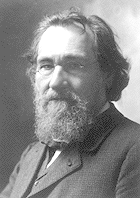Phagocytosis
 One of the great figures of 19th Century biology, Elie Metchnikoff
(1845-1916), was a Russian who lived in Paris and did his work at the Instituit Pasteur. He formulated the
basic theory on which the science of immunology is founded: that the
body is protected from infection by leukocytes that engulf bacteria
and other invading organisms. While today we regard this as an
obvious and commonplace concept, it certainly wasn't in Metchnikoff's
day, and the idea that one cell could "eat" another—Metchnikoff
coined the term "phagocytosis" which literally means "the eating of
cells"—was very controversial at the time.
One of the great figures of 19th Century biology, Elie Metchnikoff
(1845-1916), was a Russian who lived in Paris and did his work at the Instituit Pasteur. He formulated the
basic theory on which the science of immunology is founded: that the
body is protected from infection by leukocytes that engulf bacteria
and other invading organisms. While today we regard this as an
obvious and commonplace concept, it certainly wasn't in Metchnikoff's
day, and the idea that one cell could "eat" another—Metchnikoff
coined the term "phagocytosis" which literally means "the eating of
cells"—was very controversial at the time.
As hard as it may be to believe, it was only about 1885 that the
"germ theory" of the origins of disease came to be generally accepted
by the medical profession, and a lot of needless deaths occurred
because of the refusal to accept it. This was especially true in
cases of childbirth and amputations, in which nonsterile instruments
were frequently used by ignorant surgeons. Even after the concept of
infection by germs had finally been proven to be true, the argument
that certain cells played an active role in defense against
them was even harder for the establishment to swallow. Metchnikoff
was widely regarded as a crackpot and lunatic, as had been Pasteur,
Lister, and Semmelweiss before him.
The image used in this exercise is a recreation of the experiment Metchnikoff used to prove his
theory to be correct. By injecting particulate material into animals
he was able to demonstrate clearly and elegantly that phagocytosis
really does occur in specialized cells in certain locations.
Metchnikoff was later to be awarded the Nobel Prize in Physiology and
Medicine, and is today justly considered one of the founding figures
of modern medicine.

Close This Window
 One of the great figures of 19th Century biology, Elie Metchnikoff
(1845-1916), was a Russian who lived in Paris and did his work at the Instituit Pasteur. He formulated the
basic theory on which the science of immunology is founded: that the
body is protected from infection by leukocytes that engulf bacteria
and other invading organisms. While today we regard this as an
obvious and commonplace concept, it certainly wasn't in Metchnikoff's
day, and the idea that one cell could "eat" another—Metchnikoff
coined the term "phagocytosis" which literally means "the eating of
cells"—was very controversial at the time.
One of the great figures of 19th Century biology, Elie Metchnikoff
(1845-1916), was a Russian who lived in Paris and did his work at the Instituit Pasteur. He formulated the
basic theory on which the science of immunology is founded: that the
body is protected from infection by leukocytes that engulf bacteria
and other invading organisms. While today we regard this as an
obvious and commonplace concept, it certainly wasn't in Metchnikoff's
day, and the idea that one cell could "eat" another—Metchnikoff
coined the term "phagocytosis" which literally means "the eating of
cells"—was very controversial at the time.
